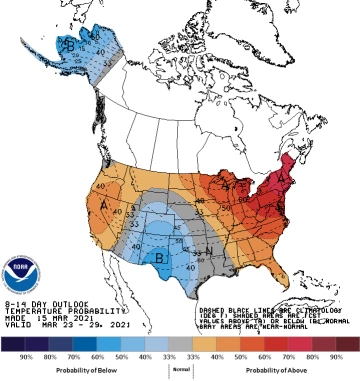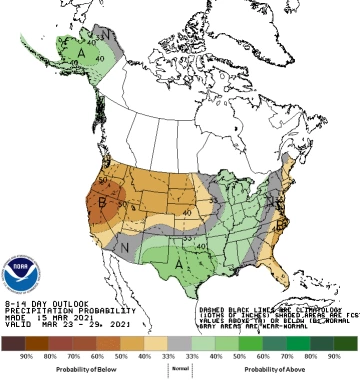< Back to Climate Viticulture Newsletter
Hello, everyone!
This is a March 2021 special issue of the Climate Viticulture Newsletter – a quick look at some timely climate topics relevant to winegrape growing in Arizona and New Mexico.
Vine Dormancy and the Start of the Growing Season
The storyline has not changed much since the start of this month. Values of both cumulative chill portions and cumulative growing degree days continue to closely track those observed during the past two years, winters 2019-2020 and 2018-2019, at the AZMET Willcox Bench station in the south-central part of the Willcox AVA (green, pink, and blue lines on graphs). Based on degree-day calculations from the National Phenology Network, heat accumulations for other warm-climate growing areas in the region also appear similar to those from this time last year.
With this comparison of chill and heat accumulations between the current year and past ones, we once again are taking the ‘analogs’ page from the weather forecasting playbook. Such an approach there looks at impacts recorded during past weather events that are like the one being forecasted to give forecasters a better idea of potential upcoming impacts. In our context, we are simply trying to get a better idea of when the growing season might start by pairing information in these graphs with your observations from previous years.

Jeremy Weiss
The Outlook for Late March Temperature and Precipitation
As we approach the end of the month, there are equal chances for below-, near-, or above-normal temperatures for western Arizona (gray area on map). For eastern Arizona and western and northern New Mexico, there is a slight increase in chances for below-normal temperatures (light blue and blue areas on map). A moderate increase in chances for below-normal temperatures exists for southern New Mexico (dark blue area on map).

NOAA CPC
A slight increase in chances for below-normal precipitation exists for extreme northern Arizona (light tan area on map). In contrast, a slight increase in chances for above-normal precipitation exists for the extreme southeastern part of the state and for most of New Mexico (light green and green areas on map). Otherwise, there equal chances for below-, near-, or above-normal precipitation for the region. Given current chill and heat accumulations, and since these outlooks are not altogether different from what we were looking at this time last year, we would not be surprised if bud break dates are similar to those of the past two growing seasons for warm-climate growing areas in the region.
To stay informed of long-range temperature and precipitation possibilities beyond the coverage of a standard weather forecast, NOAA’s Climate Prediction Center issues daily a six-to-ten-day outlook and the eight-to-fourteen-day outlook presented here.

NOAA CPC
To add to the 'analogs' approach above, we are taking steps to develop region-specific phenological models that predict not only bud break, but also flowering and veraison. Such models can be useful for near-term planning of vineyard activities, as well as for anticipating long-term changes in growth-stage timing from further increases in seasonal temperatures that can alter spring freeze risk and the conditions under which fruit ripens. Having many observations from many locations as input data makes for better models. If you are interested in contributing your phenological data from previous growing seasons, please let us know. Or, if you are interested in collecting growth-stage information and need a starting point, see pages 2 through 4 of this document from the Australian Wine Research Institute.
Besides the start of the growing season, late March and early April also bring the climatological last spring freeze to warm-climate growing areas in the region. For those of you in southeastern Arizona, Cooperative Extension manages an email listserv in coordination with the Tucson forecast office of the National Weather Service to provide information in the days leading up to such agriculturally important events. Please contact us if you'd like to sign up.
A recent donation of 40 acres near Willcox plus recent funding from the USDA-AZDA Specialty Crop Block Grant program are some of the first steps of a newly formed public-private collaboration towards a Viticulture Center of Research (VCOR) that will help support winegrape growing in Arizona. The funding will provide resources to convene the state viticulture industry and its supporters in the latter half of 2021 to determine common interests and develop plans for moving the VCOR project forward. Another first step is to gather letters of support that demonstrate backing of the VCOR project from the Arizona viticulture industry to relevant leaders in the University of Arizona. To learn more about the VCOR project and how to contribute a letter of support, please contact Joshua Sherman, commercial horticulture agent with University of Arizona Cooperative Extension.
Undergraduate students in the College of Agriculture and Life Sciences at the University of Arizona are looking for internships with businesses and companies in the viticulture and winery industries during 2021. Please contact Danielle Buhrow, Senior Academic Advisor and Graduate Program Coordinator in the Department of Agricultural and Resource Economics, for more information.
Please feel free to give us feedback on this special issue of the Climate Viticulture Newsletter, suggestions on what to include more or less often, and ideas for new topics.
Did someone forward you this newsletter? Please contact us to subscribe.
Have a wonderful rest of March!
With support from:




